Textile Bandwidth-Enhanced Polarization-Reconfigurable Half-Mode Substrate-Integrated Cavity Antenna
Abstract
:1. Introduction
2. Basic Textile HMSIC Antenna
3. Textile Bandwidth-Enhanced Slotted HMSIC Antenna
4. Textile Polarization-Reconfigurable HMSIC Antenna Based on Snap Buttons
4.1. Geometry Design
4.2. Simulation Results
4.3. Measurement Results
5. Conclusions
Author Contributions
Funding
Data Availability Statement
Conflicts of Interest
References
- Lin, X.; Chen, Y.; Gong, Z.; Seet, B.; Huang, L.; Lu, Y. Ultrawideband textile antenna for wearable microwave medical imaging applications. IEEE Trans. Antennas Propag. 2020, 68, 4238–4249. [Google Scholar] [CrossRef]
- Galehdar, A.; Thiel, D.V. Flexible, light-weight antenna at 2.4 GHz for athlete clothing. In Proceedings of the 2007 IEEE Antennas and Propagation Society International Symposium, Honolulu, HI, USA, 9–15 June 2007. [Google Scholar]
- Lee, H.; Tak, J.; Choi, J. Wearable antenna integrated into military berets for indoor/outdoor positioning system. IEEE Antennas Wirel. Propag. Lett. 2017, 16, 1919–1922. [Google Scholar] [CrossRef]
- Hertleer, C.; Rogier, H.; Vallozzi, L.; Langenhove, L.V. A textile antenna for off-body communication integrated into protective clothing for firefighters. IEEE Trans. Antennas Propag. 2009, 57, 919–925. [Google Scholar] [CrossRef]
- Agneessens, S.; Lemey, S.; Vervust, T.; Rogier, H. Wearable, small, and robust: The circular quarter-mode textile antenna. IEEE Antennas Wirel. Propag. Lett. 2015, 14, 1482–1485. [Google Scholar] [CrossRef]
- Yan, S.; Volskiy, V.; Vandenbosch, G.A.E. Compact dual-band textile PIFA for 433-MHz/2.4-GHz ISM bands. IEEE Antennas Wirel. Propag.Lett. 2017, 16, 2436–2439. [Google Scholar] [CrossRef]
- Simorangkir, R.B.V.B.; Yang, Y.; Matekovits, L.; Esselle, K.P. Dual-band dual-mode textile antenna on PDMS substrate for body-centric communications. IEEE Antennas Wirel. Propag. Lett. 2017, 16, 677–680. [Google Scholar] [CrossRef]
- Mao, C.-X.; Vital, D.; Werner, D.H.; Wu, Y.; Bhardwaj, S. Dual-polarized embroidered textile armband antenna array with omnidirectional radiation for on-/off-body wearable applications. IEEE Trans. Antennas Propag. 2019, 68, 2575–2584. [Google Scholar] [CrossRef]
- Paracha, K.N.; Rahim, S.K.A.; Soh, P.J.; Khalily, M. Wearable antennas: A review of materials, structures, and innovative features for autonomous communication and sensing. IEEE Access 2019, 7, 56694–56712. [Google Scholar] [CrossRef]
- Hong, W.; Liu, B.; Wang, Y.; Lai, Q.; Tang, H.; Yin, X.X.; Dong, Y.D.; Zhang, Y.; Wu, K. Half-mode substrate-integrated waveguide: A new guided wave structure for microwave and millimeter wave application. In Proceedings of the 2006 Joint 31st International Conference on Infrared Millimeter Waves and 14th International Conference on Teraherz Electronics, Shanghai, China, 18–22 September 2006. [Google Scholar]
- Lai, Q.; Fumeaux, C.; Hong, W.; Vahldieck, R. Characterization of the propagation properties of the half-mode substrate integrated waveguide. IEEE Trans. Microw. Theory Technol. 2009, 57, 1996–2004. [Google Scholar]
- Agneessens, S.; Rogier, H.S. Compact half diamond dual-band textile HMSIW on-body antenna. IEEE Trans. Antennas Propag. 2014, 62, 2374–2381. [Google Scholar] [CrossRef]
- Kaufmann, T.; Fumeaux, C. Wearable textile half-mode substrate-integrated cavity antenna using embroidered vias. IEEE Antennas Wirel. Propag. Lett. 2013, 12, 805–808. [Google Scholar] [CrossRef]
- Liu, F.; Kaufmann, T.; Xu, Z.; Fumeaux, C. Wearable applications of quarter-wave patch and half-mode cavity antennas. IEEE Antennas Wirel. Propag. Lett. 2015, 14, 1478–1481. [Google Scholar] [CrossRef]
- Caytan, O.; Lemey, S.; Agneessens, S.; Ginste, D.V.; Demeester, P.; Loss, C.; Salvado, R.; Rogier, H. Half-mode substrate-integrated-waveguide cavity-backed slot antenna on cork substrate. IEEE Antennas Wirel. Propag. Lett. 2016, 15, 162–165. [Google Scholar] [CrossRef]
- Pinapati, S.P.; Ranasinghe, D.C.; Fumeaux, C. Bandwidth enhanced dual-band half-mode substrate-integrated cavity antenna. In Proceedings of the 2018 Australian Microwave Symposium, Brisbane, Australia, 6–7 February 2018. [Google Scholar]
- Gao, G.-P.; Yang, C.; Hu, B.; Zhang, R.-F.; Wang, S.-F. A wide-bandwidth wearable all-textile PIFA with dual resonance modes for 5 GHz WLAN applications. IEEE Trans. Antennas Propag. 2019, 67, 4206–4211. [Google Scholar] [CrossRef]
- Cui, J.; Liu, F.-X.; Yin, H.; Zhao, L. Textile via-loaded bandwidth-enhanced half-mode substrate-integrated cavity antenna for WLAN communications. IEEE Trans. Antennas Propag. 2022, 70, 6551–6559. [Google Scholar] [CrossRef]
- Liu, F.-X.; Cui, J.; Wang, J.; Zhao, L. Textile Bandwidth-Enhanced Half-Mode Substrate-Integrated Cavity Antenna with V-Slot for WLAN Communications. IEEE Antennas Wirel. Propag. Lett. 2023, 22, 333–336. [Google Scholar] [CrossRef]
- Musa, U.; Shah, S.M.; Majid, H.A.; Abidin, Z.Z.; Yahya, M.S.; Babani, S.; Yunusa, Z. Recent advancement of wearable reconfigurable antenna technologies: A review. IEEE Access 2022, 10, 121831–121863. [Google Scholar] [CrossRef]
- Lee, H.; Choi, J. A polarization reconfigurable textile patch antenna for wearable IoT applications. In Proceedings of the 2017 International Symposium on Antennas and Propagation, Phuket, Thailand, 30 October–2 November 2017. [Google Scholar]
- Cil, E.; Dumanli, S. The design of a reconfigurable slot antenna printed on glass for wearable applications. IEEE Access 2020, 8, 95417–95423. [Google Scholar] [CrossRef]
- Chen, S.J.; Ranasinghe, D.C.; Fumeaux, C. A robust snap-on button solution for reconfigurable wearable textile antennas. IEEE Trans. Antennas Propag. 2018, 66, 4541–4551. [Google Scholar] [CrossRef]
- Dang, Q.H.; Chen, S.J.; Ranasinghe, D.C.; Fumeaux, C. A frequency-reconfigurable wearable textile antenna with one octave tuning range. IEEE Trans. Antennas Propag. 2021, 69, 8080–8089. [Google Scholar] [CrossRef]
- Tsolis, A.; Michalopoulou, A.; Alexandridis, A.A. Use of conductive zip and Velcro as a polarisation reconfiguration means of a textile patch antenna. IET Microw. Antennas Propag. 2020, 14, 684–693. [Google Scholar] [CrossRef]
- Cui, J.; Liu, F.-X.; Zhao, L.; Dou, W. Textile fixed-frequency pattern-reconfigurable coupled-mode substrate-integrated cavity antenna. IEEE Antennas Wirel. Propag. Lett. 2022, 21, 1916–1919. [Google Scholar] [CrossRef]
- Liu, F.-X.; Dou, W.-B.; Cui, J.; Chen, S.J.; Fumeaux, C. A concept of pattern-reconfigurable single-element antenna based on half-mode substrate-integrated cavity. In Proceeding of the 2020 14th European Conference on Antennas and Propagation, Copenhagen, Denmark, 15–20 March 2020. [Google Scholar]
- Hasgall, P.A.; Neufeld, E.; Gosselin, M.C.; Klingenböck, A.; Kuster, N.; Klingenbock, A.; Hasgall, P.; Gosselin, M. It’is Database for thermal and electromagnetic parameters of biological tissues. J. Cell Biol. 2012, 93, 170. [Google Scholar]


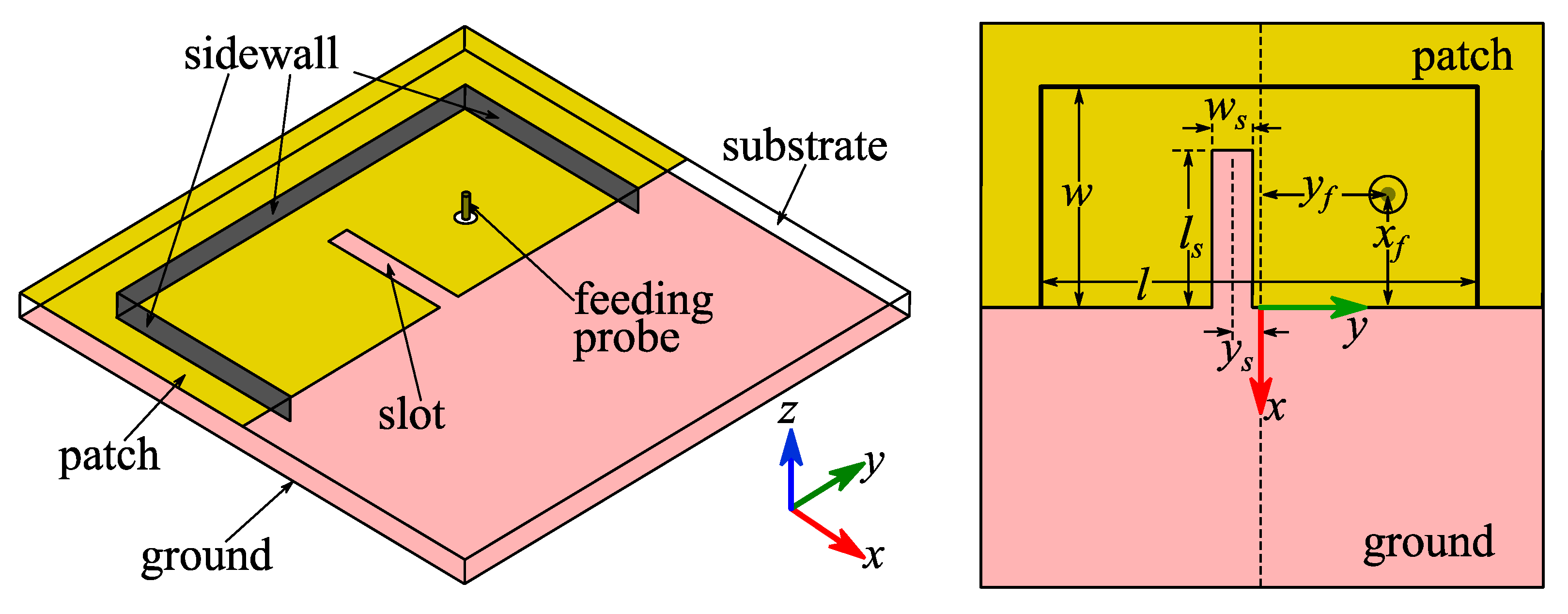
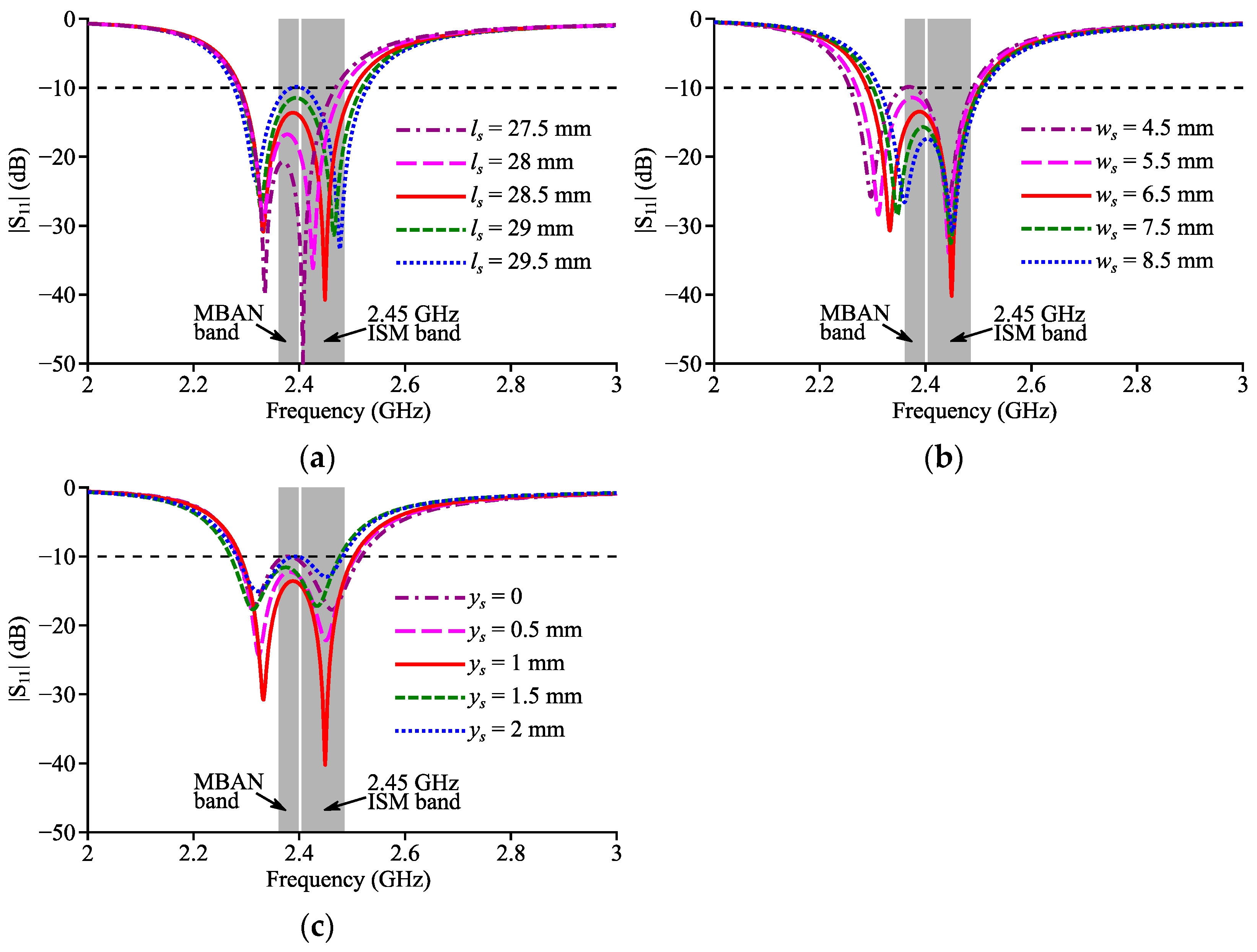
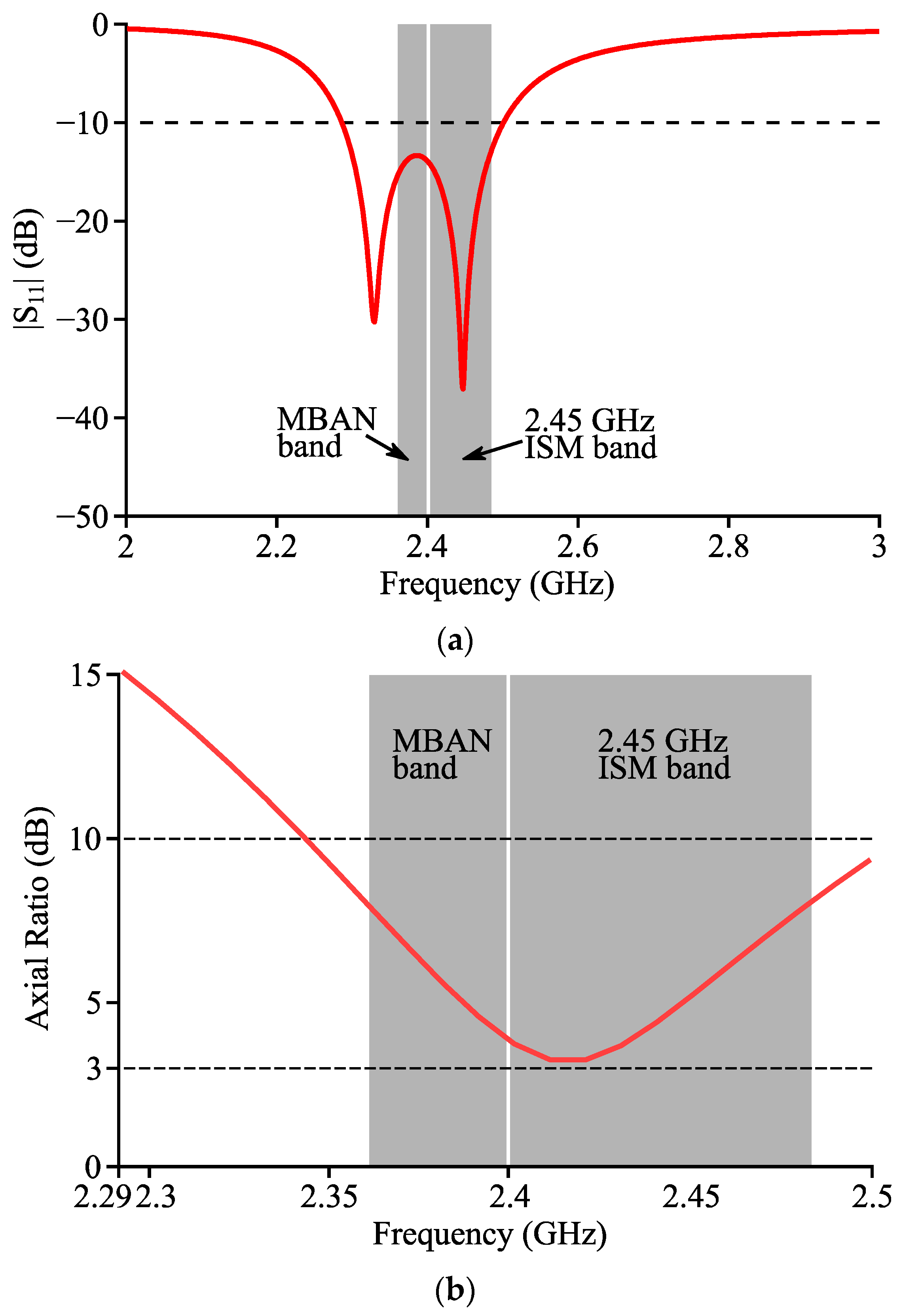
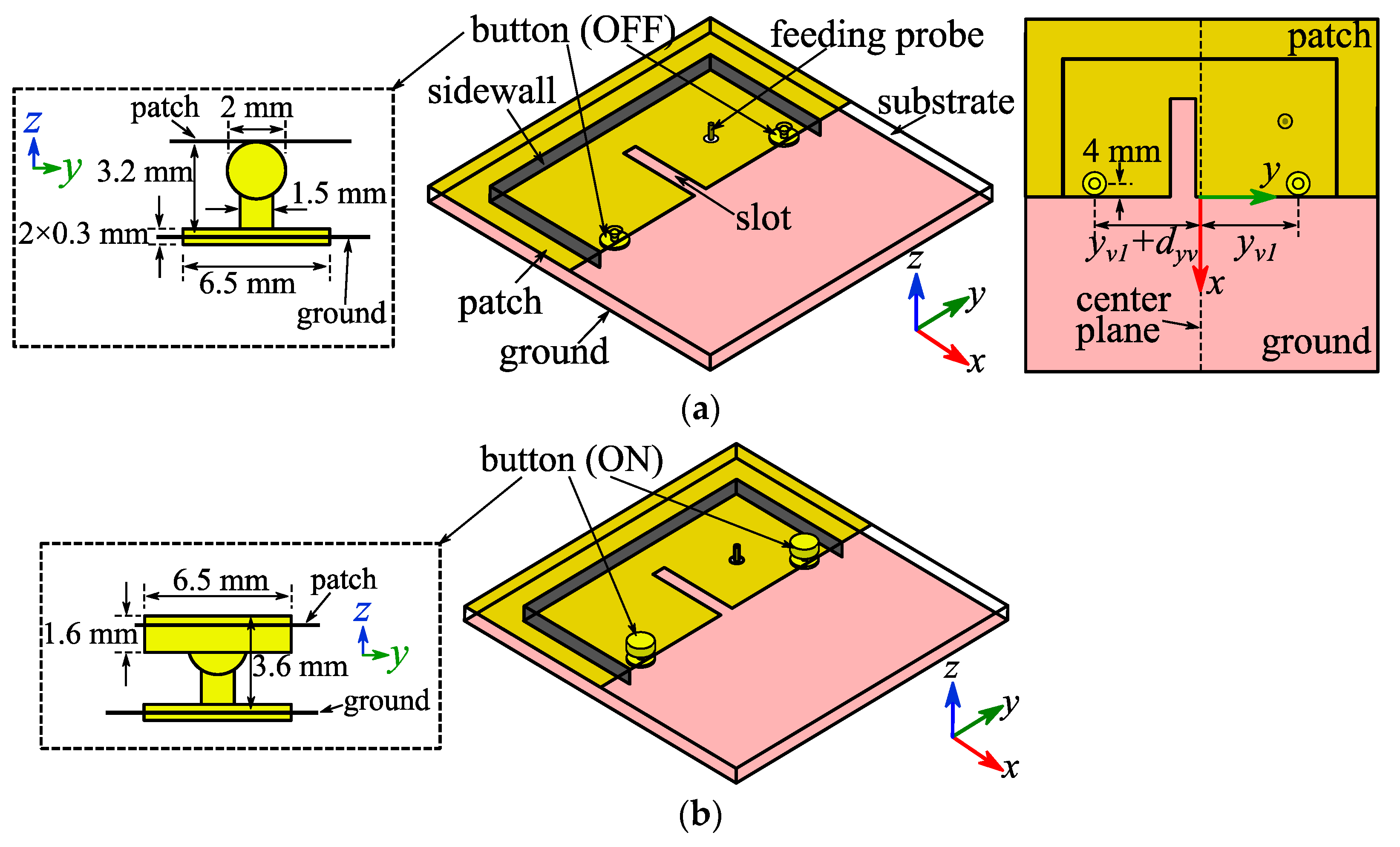


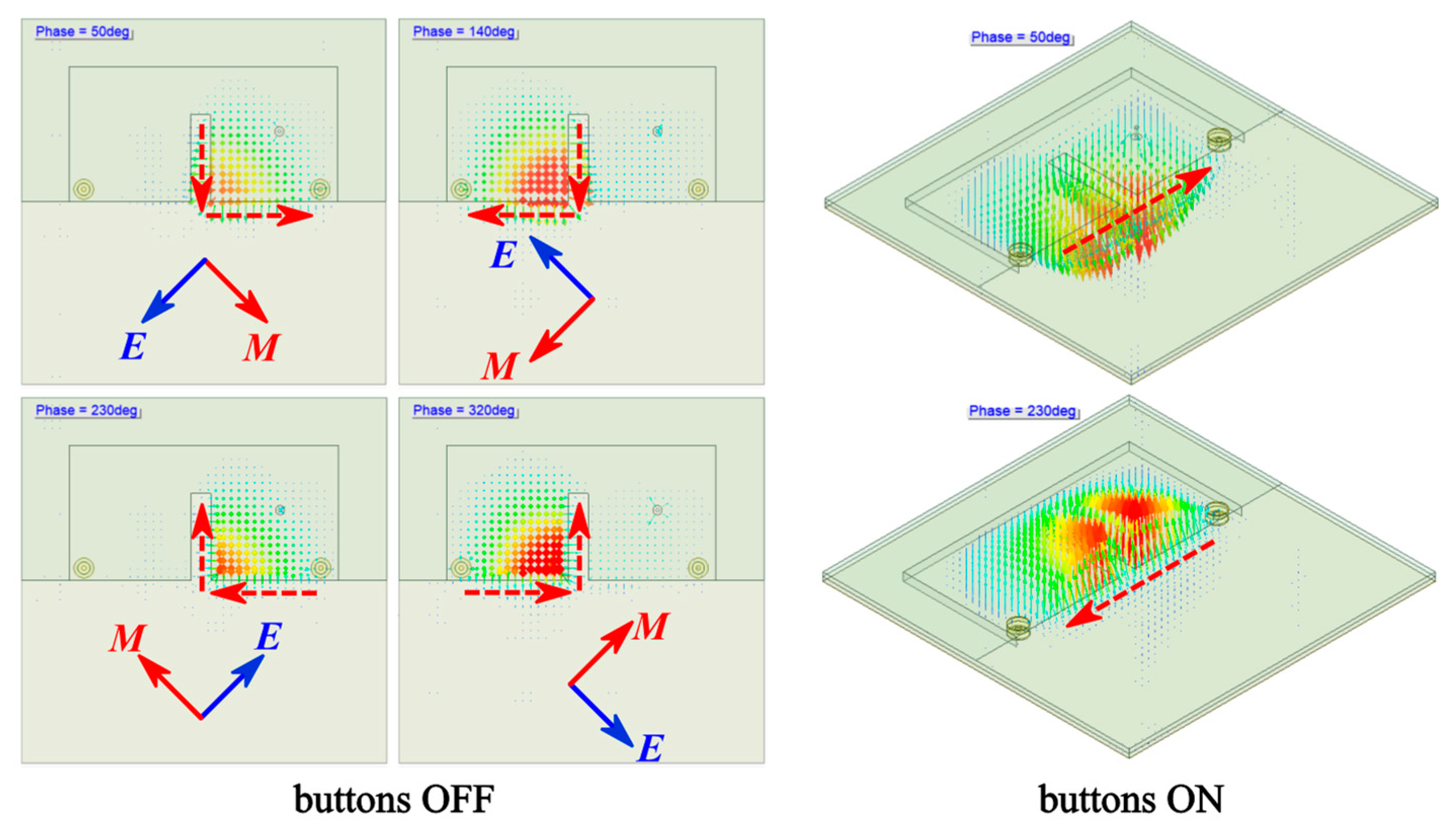
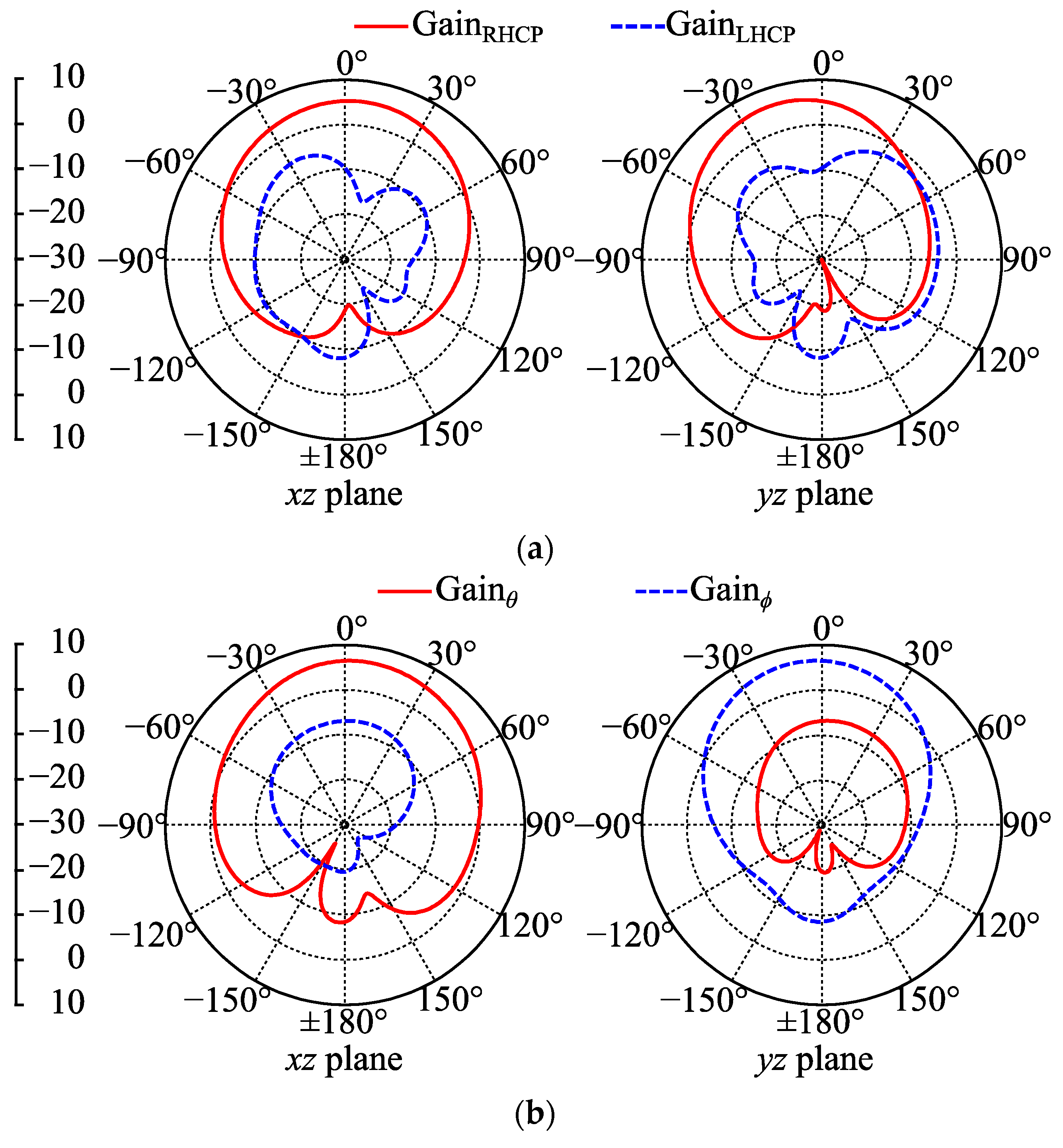
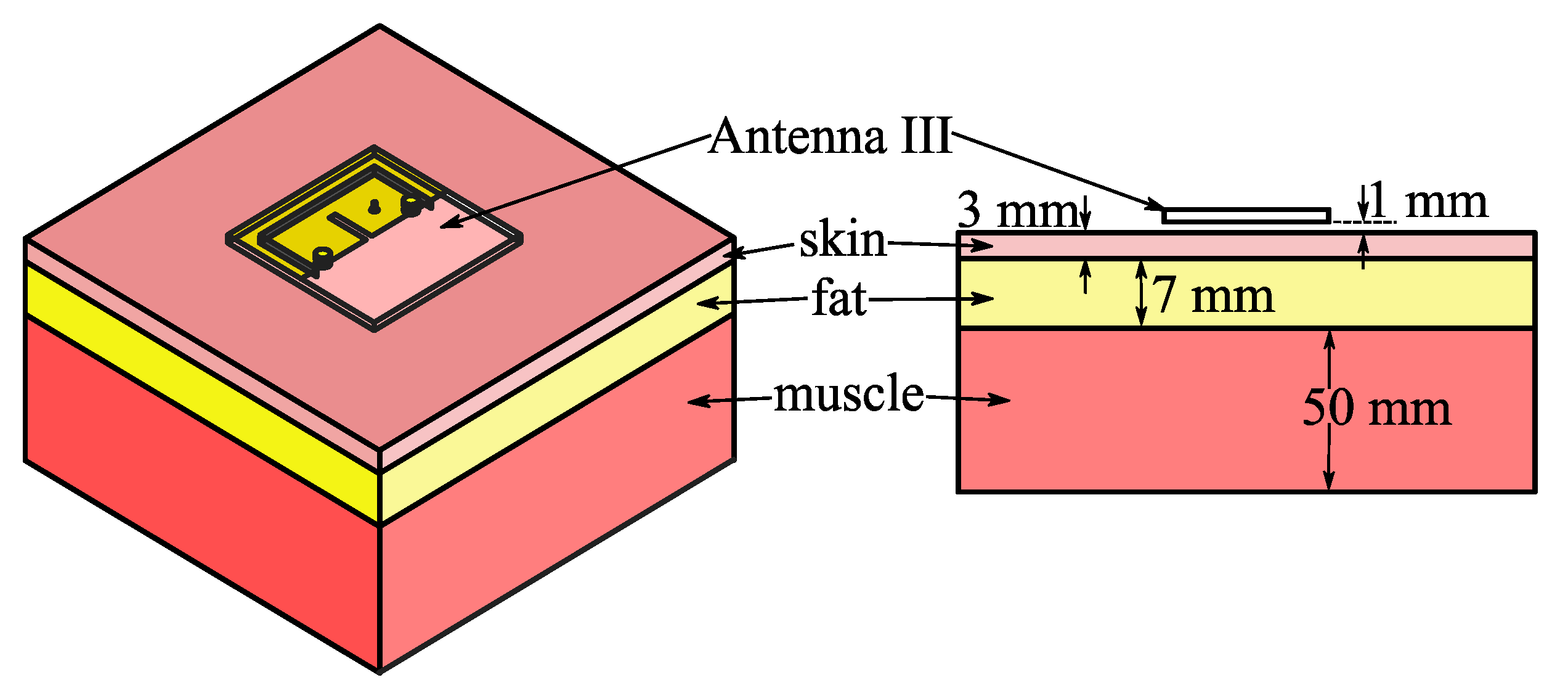
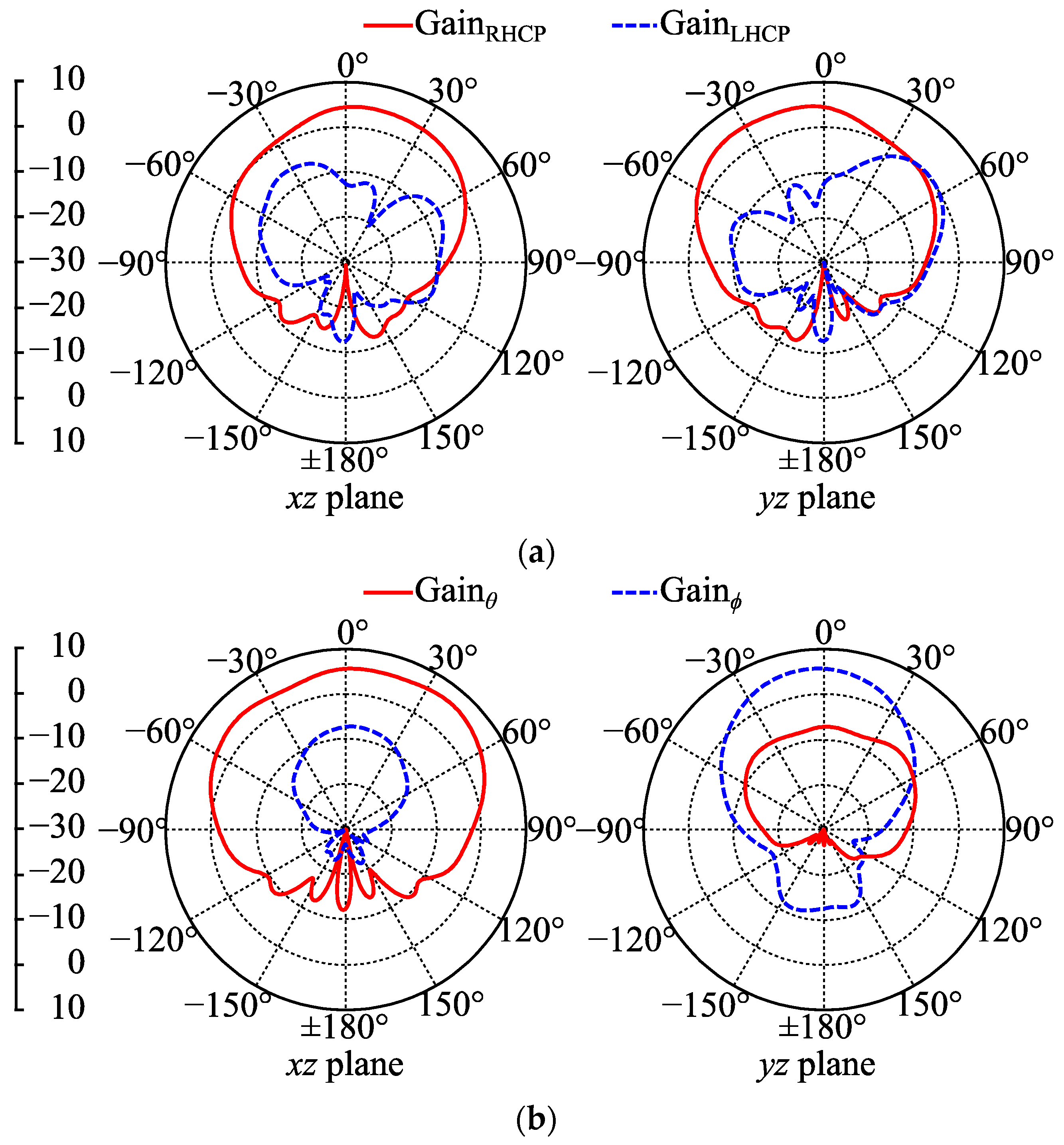
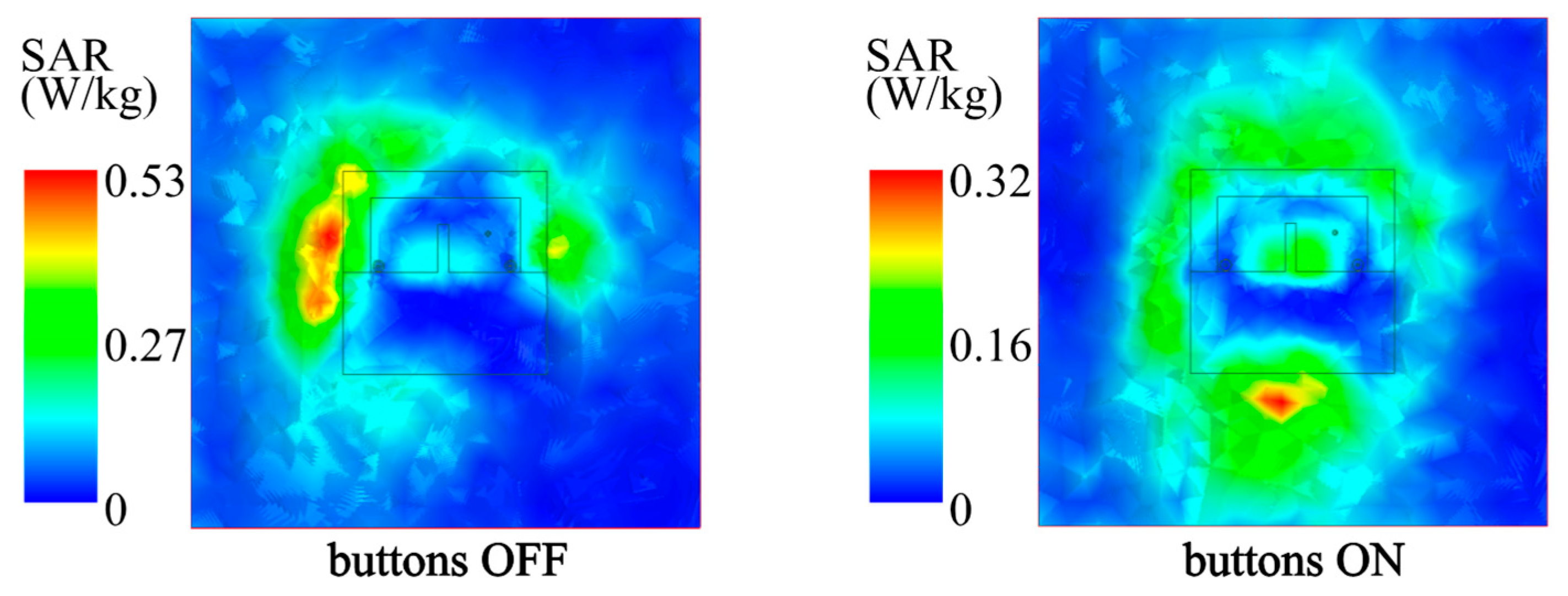
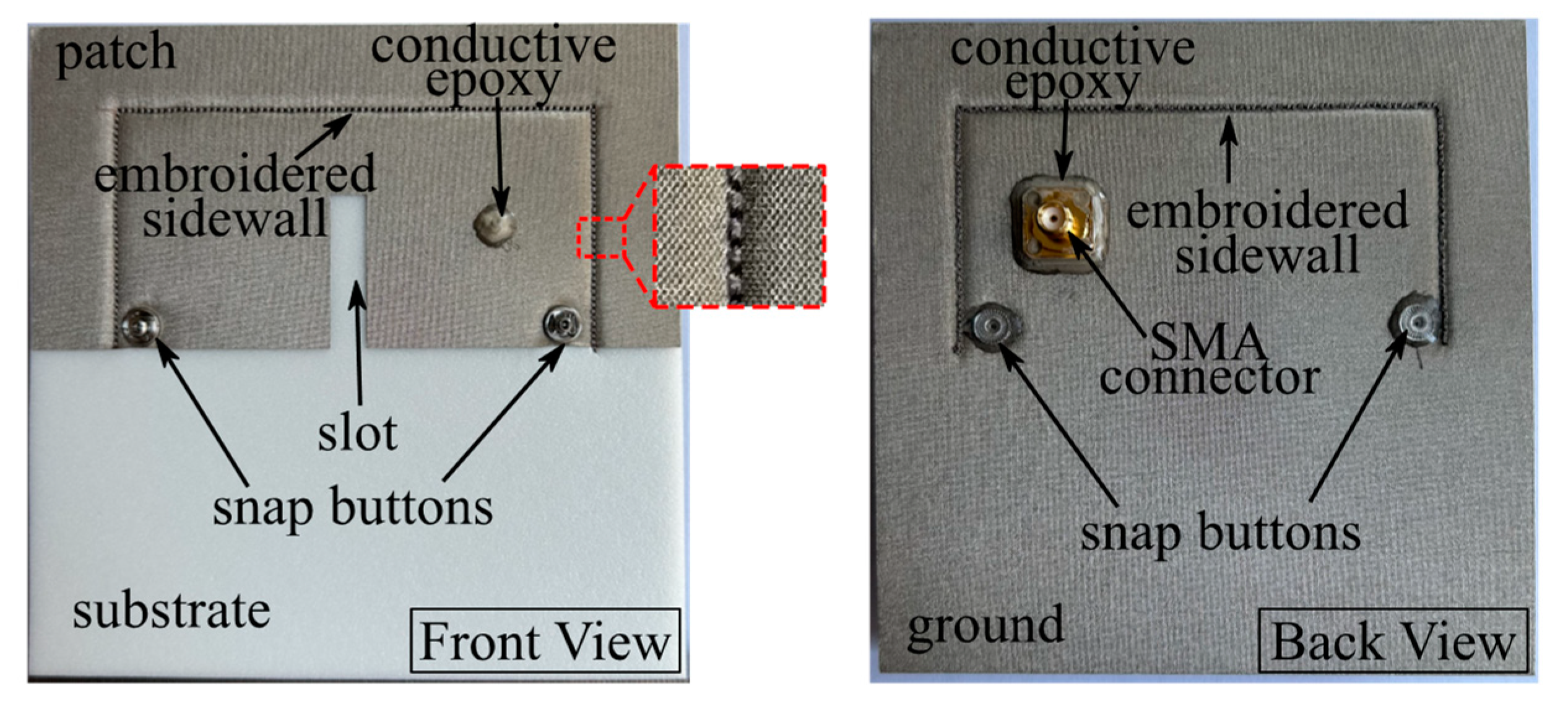

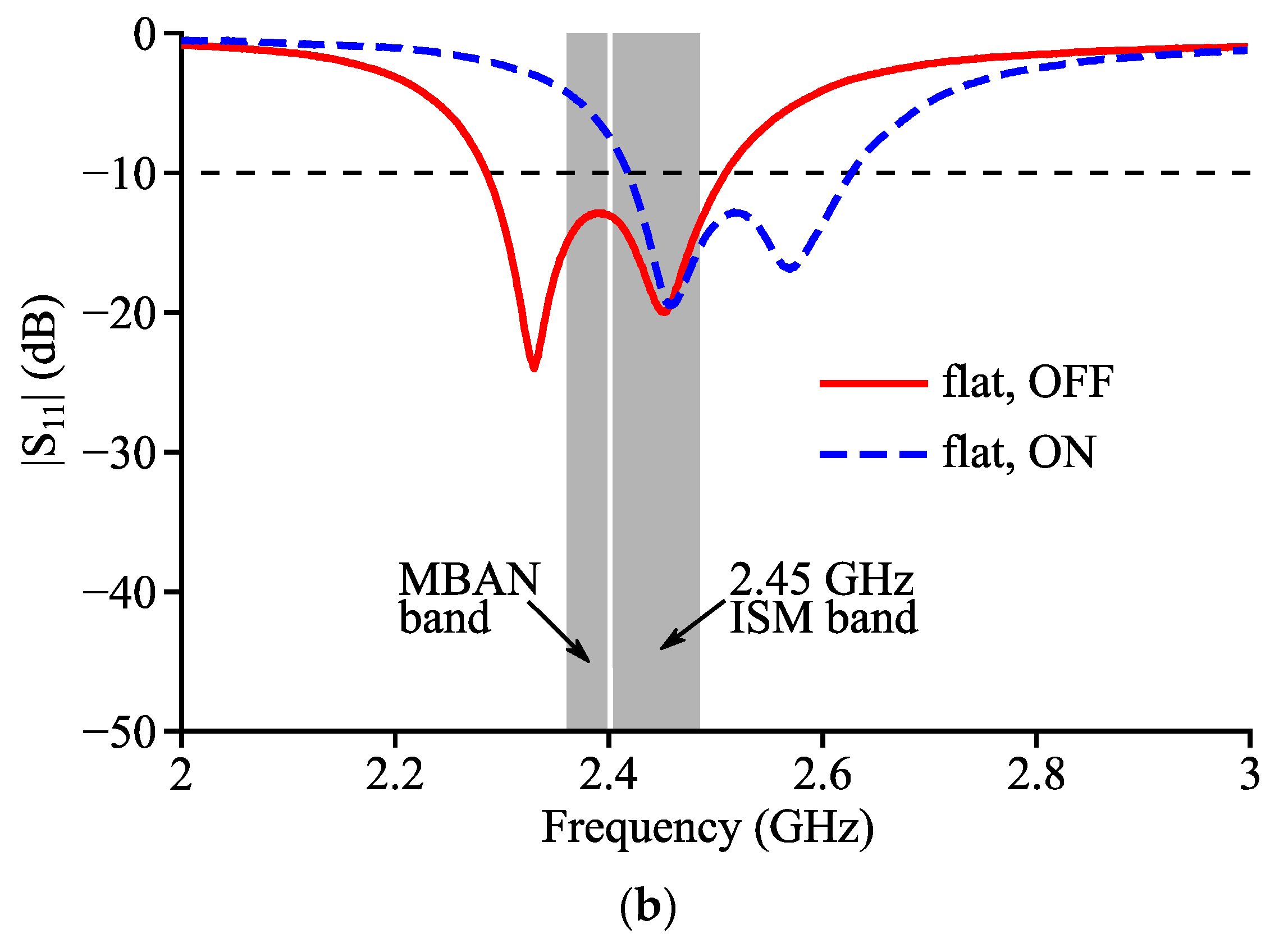
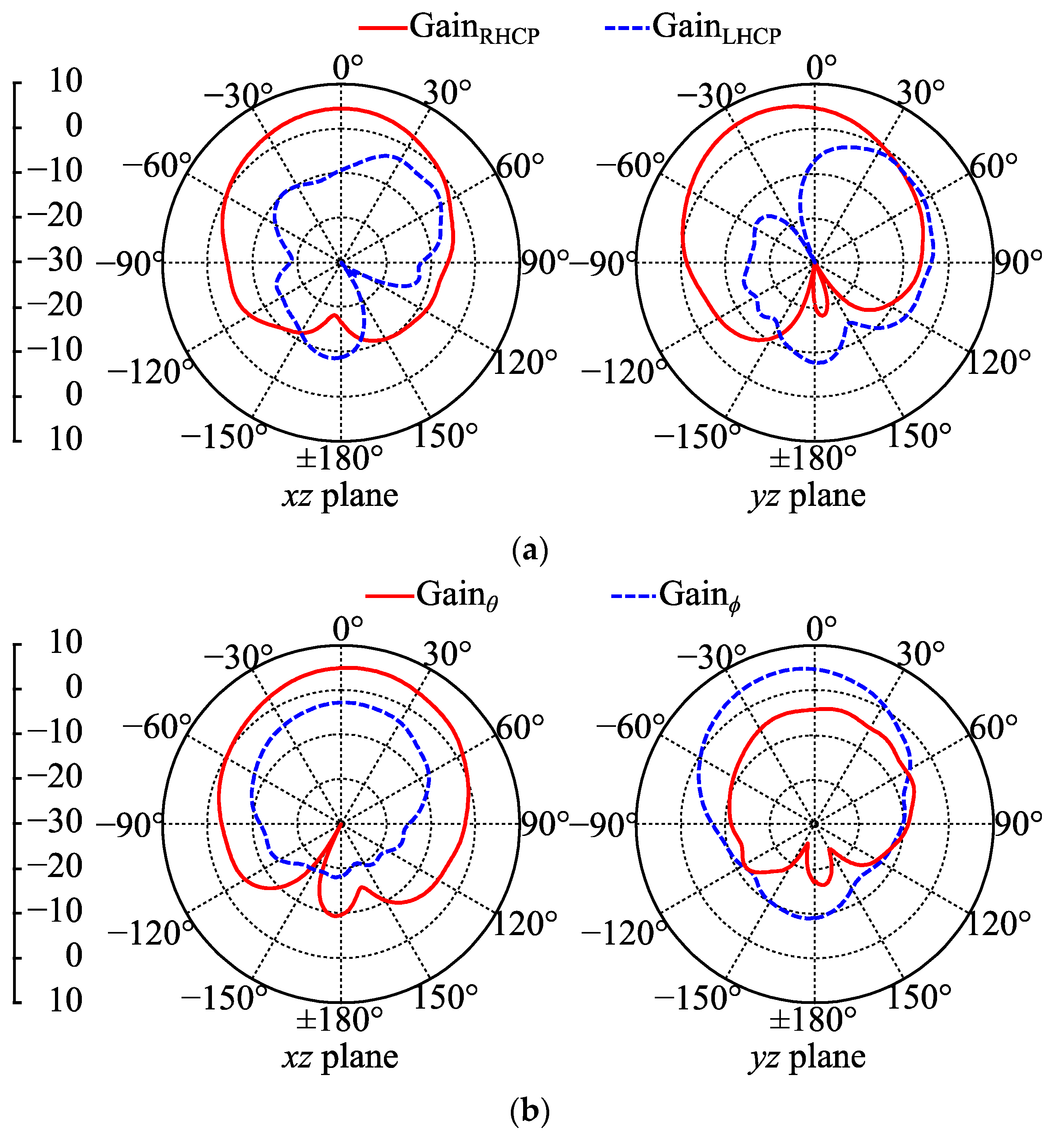
| Layer | Density (kg/m3) | Relative Permittivity | Conductivity (S/m) |
|---|---|---|---|
| Skin | 1100 | 38.09 | 1.43 |
| Fat | 910 | 5.29 | 0.1 |
| Muscle | 1041 | 52.8 | 1.69 |
| Ref. | Freq. (GHz) | Bandwidth (%) | Efficiency (%) | Cavity Size (λε2) | Antenna Size (λε2) | Polarization Reconfiguration |
|---|---|---|---|---|---|---|
| [15] | 5.5 | 23.7 | 85 | 0.364 | Not given | No |
| [16] | 2.45 | 6 | Not given | 0.22 | 0.673 | No |
| [18] | 5.5 | 14.7 | 95 | 1.073 | 3.527 | No |
| [19] | 5.5 | 15.7 | 94 | 0.245 | 1.754 | No |
| This work | 2.4 (OFF) | 9.1 (OFF) | 95 (OFF) | 0.266 (OFF) | 0.980 (OFF) | Yes (2.42 GHz) |
| 2.52 (ON) | 8.3 (ON) | 97 (ON) | 0.285 (ON) | 1.05 (ON) |
Disclaimer/Publisher’s Note: The statements, opinions and data contained in all publications are solely those of the individual author(s) and contributor(s) and not of MDPI and/or the editor(s). MDPI and/or the editor(s) disclaim responsibility for any injury to people or property resulting from any ideas, methods, instructions or products referred to in the content. |
© 2023 by the authors. Licensee MDPI, Basel, Switzerland. This article is an open access article distributed under the terms and conditions of the Creative Commons Attribution (CC BY) license (https://creativecommons.org/licenses/by/4.0/).
Share and Cite
Liu, F.-X.; Cui, J.; Meng, F.-Y.; Jiang, T.-Y.; Yan, S.-F.; Chao, S.; Zhao, L. Textile Bandwidth-Enhanced Polarization-Reconfigurable Half-Mode Substrate-Integrated Cavity Antenna. Micromachines 2023, 14, 934. https://doi.org/10.3390/mi14050934
Liu F-X, Cui J, Meng F-Y, Jiang T-Y, Yan S-F, Chao S, Zhao L. Textile Bandwidth-Enhanced Polarization-Reconfigurable Half-Mode Substrate-Integrated Cavity Antenna. Micromachines. 2023; 14(5):934. https://doi.org/10.3390/mi14050934
Chicago/Turabian StyleLiu, Feng-Xue, Jie Cui, Fan-Yu Meng, Tian-Yu Jiang, Shao-Fei Yan, Shuai Chao, and Lei Zhao. 2023. "Textile Bandwidth-Enhanced Polarization-Reconfigurable Half-Mode Substrate-Integrated Cavity Antenna" Micromachines 14, no. 5: 934. https://doi.org/10.3390/mi14050934






